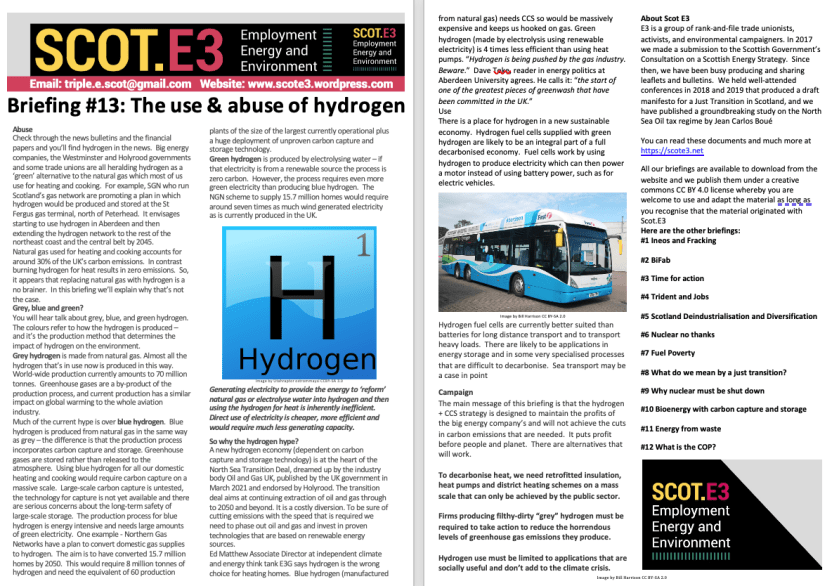On 10th December 2022 we held an online public meeting taking a critical look at the way in which the oil and gas industry and governments are using hydrogen as part of a greenwashing strategy that undermines serious progress on cutting carbon emissions.
We’re talking about Hydrogen today because of the current focus on Hydrogen in both the Westminster and Holyrood Governments’ climate policies, and because it’s also the focus of the big energy companies.
We were pleased to welcome the author and activist Simon Pirani as the main speaker. Simon is the author of Burning Up – A Global History of Fossil Fuel Consumption and has written extensively about the future for Hydrogen in a sustainable economy. He’s also the author of the highly recommended people nature blog
Here’s the video of Simon’s introduction:
If you’d like to look at Simon’s slides without the video you can view or download them here.
After Simon had spoken we welcomed Ishbel Shand who spoke briefly on behalf of the campaign to save St Fittick’s Park in Torry, Aberdeen from the threat of industrial development, which is said to be necessary for Hydrogen production and storage. Here’s the video of Ishbel’s introduction:
To find out more about the St Fitticks Campaign and the issues surrounding it do check out the report of the public meeting we held in October.
You may also like to read, download or utilise the ScotE3 briefing on the use and abuse of hydrogen.

The introductions were followed by a wide-ranging discussion. Several participants spoke about the importance of linking the cost of living crisis, action against austerity and climate.
One of the questions in the discussion was concerned with hydrogen and transport.
Do you rule out H for ALL transport uses? What about shipping, and heavy road transport – what alternatives are there for these?
In response Simon noted that:
The first options should be reducing the amount of travel: that’s a decision for society to make collectively. It can’t be left to companies who it suits to move stuff around the world cheaply. There are no simple answers to this. A good survey of the options by the Tyndall centre is here.
Another question addressed hydrogen as a means of storing energy. There were a number of responses from participants, including:
My understanding of what engineering researchers write is that batteries, hydro storage (pumping water up a hill and then down again) and other techniques are in most circumstances preferable to hydrogen. There’s also a need for all these technologies to be integrated, with an emphasis on reducing throughput. Neither the oil and gas companies or the government want to talk about this
Pumped storage hydro is the most widely used energy storage technology – in excess of 90%. It requires particular topography – there needs to be an upper and a lower reservoir with a significant distance between them. Scotland has many good sites, but the last plant was built in 1965 (Cruachan).
Another option for storage is to use large scale heat pump technology that could also underpin district heating schemes. The technology is fairly straightforward. It would be flexible and local.
There’s a Finnish company, polar night, that have developed a thermal storage system using sand. An Italian company is using a carbon dioxide “battery” – there are lots of alternatives.
There are also domestic thermal stores using phase change materials, which enables load spreading on a short term basis.
Another question referred to so-called turquoise hydrogen. Simon’s response was:
Turqoise hydrogen, i.e. producing hydrogen from methane pyrolysis. It’s at a very early stage, i.e. in the lab. It might work, might not. The Russian company Gazprom was investing in it 2-3 years back, as they have huge amounts of cheap gas. But obviously this year their business has been sacrificed to the government’s aim of bullying Ukraine, and even if they have made any progress I doubt that we would hear about it.
There was a question about whether steel could be recycled and it was confirmed that it can be, and is, although not on as big. a scale as would be desirable.

One thought on “Hydrogen: the technofix that undermines climate action”